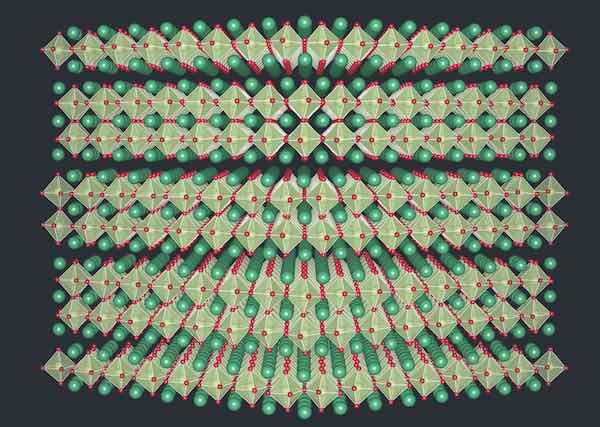
[Image above] Layered perovskites can completely turn off polarization if enough strain is applied to them. Credit: James Rondinelli
Editor’s note: This story originally appeared in print in the August 2016 ACerS Bulletin.
Spontaneous electric polarization sounds like something out of a science fiction movie.
But this is science, people, not fiction—and ferroelectric materials have the ability to spontaneously polarize under strain.
That ability makes the materials useful for capacitors that go into a whole host of applications, from ultrasound machines to cameras to fuel injectors.
While scientists had thought they had ferroelectricty mostly figured out, however, a team of Northwestern University materials scientists is throwing paradigms out the window.
“The conventional wisdom is that you can put almost any material under mechanical stress, and provided the stress is coherently maintained, the material will become ferroelectric or exhibit an electrical polarization,” James Rondinelli, assistant professor of materials science and engineering at Northwestern Engineering, says in a Northwestern press release. “If you apply similar stresses to a compound that’s already ferroelectric, then its polarization increases.”
Or so scientists thought.
But through quantum mechanical simulations, Rondinelli and his team have discovered that some ferroelectric materials are hiding a surprise. Layered perovskites don’t conform to conventional wisdom—instead, these materials completely turn off polarization if enough strain is applied to them.
Rondinelli and his team are no strangers to breaking conventional wisdom. Their previous work devised new routes to develop multiferroic materials—those with both ferroelectricity and ferromagnetism, two properties that were usually thought to be mutually exclusive.
The team’s new work hones in on only ferroelectricity, but uncovers an important and previously unknown feature of layered perovskites, a type of ferroelectric oxide.
“For some time now, strain engineering in thin films has been used to improve or control dielectric properties of ceramics—largely to increase the polarization or increase the ferroelectric Curie temperature [the temperature at which a material becomes ferroelectric],” Rondinelli explains via email.
“We show that too much of a good thing is actually bad. Too much strain will turn off the functional ferroelectric response—the polarization goes exactly to zero and the strain engineering does not lead to enhanced polarization. In addition, these materials in thin film form behave very differently from bulk crystals of the same material, which show good ferroelectric properties,” Rondinelli adds.
Although stretching or compressing layered perovskites initially makes them behave as expected—by increasing polarization—further strain shuts down polarization. That means that the materials might find use as switches in electronic devices.
Knowing the strain at which the material switches its properties means that devices that use the materials can be designed to take advantage of that switch function, like logic devices or memory elements, Rondinelli says—“you can apply a small electric field to traverse this boundary and simultaneously read and write the on-and-off state.”
And the scientists already know how much strain should be required to switch layered perovskites.
“When we include finite temperature effects in our calculation, we predict the transition should occur in Ca3Ti2O7 films near –2.5% and 1.2%,” Rondinelli says. “In other A3B2O7 oxides we studied, the transition is also around these strain values.”
Rondinelli adds that his team thinks new substrates currently being developed will also be able to confirm their strain predictions, too.
In addition to new applications for the materials, however, this new property of layered perovskites also means that scientists have to be careful when using the materials for existing applications, Rondinelli says. “Knowing when the properties will turn on and off is key to maintaining the expected performance of these materials.”
According to the release, the team is now working with collaborators to validate their predications in experimental setups.
Rondinelli says they’re ready to begin those experiments, although they won’t be without challenges—namely finding suitable substrates to get the desired strain state and being able to grow films to a thickness below which coherent strain is maintained. “Although the synthesis is not overly complex (e.g., with MBE or PLD), the challenge is in showing that a property does not exist.”
The paper, published in Nature Materials, is “Epitaxial-strain-induced polar-to-nonpolar transitions in layered oxides” (DOI: 10.1038/nmat4664).
